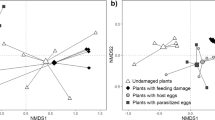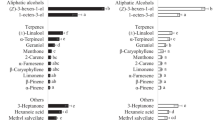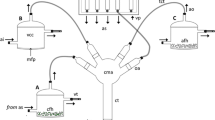Abstract
Olfactory bioassays were performed to investigate the specific odors utilized as host location cues by the beetle parasitoid, Scleroderma guani (Hymenoptera: Bethylidae), a primary biological control agent against Monochamus alternates (Coleoptera: Cerambycidae), the most important vector beetle of the pinewood nematode, Bursaphelenchus xylophilus (Nematoda: Aphelenchoididae), the causal agent for pine wilt disease. Female parasitoids were tested with volatiles and extracts derived from their host beetle. Behavioral assays (Y-olfactometer bioassay and circle arena) demonstrated the response of female parasitoids to odors from host plants damaged by beetle larvae and from their excreta. When available contact cues were additionally provided, the parasitoids showed particularly strong preferences for samples of fresh brown frass of larval beetles. To confirm the electroantennograms (EAG) activity of identified compounds, analyses were repeated with a synthetic blend composed predominantly of compounds in the crude extracts that had revealed apparent electrophysiological activity. Antennal responses to four monoterpenes and three oxygenated monoterpenes were among the strongest, which indicated their potential for use in development of semichemial-based management of the beetle.



Similar content being viewed by others
References
Borden JH, Hunt DWA, Miller DR, Slessor KN (1986) Orientation in forest Coleoptera: an uncertain outcome of responses by individual beetles to variable stimuli. In: Payne TL, Birch MC, Kennedy CE (eds) Mechanisms in insect olfaction. Oxford University Press, Oxford, pp 97–109
Bruce TJA, Wadhams LJ, Woodcock CM (2005) Insect host location: a volatile situation. Trend Plant Sci 10:270–274
Ding Y, Lu C, Han B, Pu H, Wu M (2001) Relationship among growth potential of pine, population density of Monochamus alternatus, and pathogenicity of Bursaphelenchus xylophilus. Chin J Appl Ecol 12:351–354
Evans HE (1964) A synopsis of the American Bethylidae (Hymenoptera: Aculeata). Bull Mus Comp Zool 132:1–222
Fan JT, Sun JH, Shi J (2007) Attraction of the Japanese pine sawyer, Monochamus alternatus, to volatiles from stressed host in China. Ann For Sci 64:67–71
Fawcett TW, Johnstone RA (2003) Mate choice in the face of costly competition. Behav Ecol 14:771–779
Gauld ID, Hanson PE (1995) The chrysidoid families. In: Hanson PE, Gauld ID (eds) The Hymenoptera of Costa Rica. Oxford University Press, Oxford, pp 464–503
Harrison GD (1987) Host-plant discrimination and evolution of feeding preference in the Colorado potato beetle Leptinotarsa decemlineata. Physiol Entomol 12:407–415
Hart SJ (2013) The early stage of wood decay: wood/fungus interaction and its attraction to xylophagous Coleoptera, especially cerambycids and their hymenopteran parasitoids. PhD Dissertation. Imperial College, London
Held DW, Gonsiska P, Potter DA (2003) Evaluating companion planting and non-host masking odors for protecting roses from the Japanese beetle (Coleoptera: Scarabaeidae). J Econ Entomol 96:81–87
Lauzière I, Brodeur J, Pérez-Lachaud G (2001) Host stage selection and suitability in Cephalonomia stephanoderis Betrem (Hymenoptera: Bethylidae), a parasitoid of the coffee berry borer. Biol Control 21:128–133
Leufvén A (1987) Chemical interactions between the spruce bark beetle (Ips typographus), its host tree (Picea abies), and associated microorganisms (especially yeasts) during tree colonisation. PhD Dissertation. Department of Chemical Ecology, Göteborg University, Sweden
Li L, Miller DR, Sun JH (2009) The influence of prior experience on preference and performance of a cryptoparasitoid Scleroderma guani (Hymenoptera: Bethylidae) on beetle hosts. Ecol Entomol 34:725–734
Li L, Wei W, Liu ZD, Sun JH (2010) Host adaptation of a gregarious parasitoid Sclerodermus harmandi in artificial rearing. BioControl 55:465–472
Lu D, Li X, Liu X, Zhang Q (2007) Identification and molecular cloning of putative odorant-binding proteins and chemosensory protein from the Bethylid wasp, Scleroderma guani Xiao et Wu. J Chem Ecol 33:1359–1375
Pettersson E (2001a) Volatile attractants for three Pteromalid parasitoids attacking concealed spruce bark beetles. Chemoecology 11:89–95
Pettersson E (2001b) Volatiles from potential hosts of Rhopalicus tutela a bark beetle parasitoid. J Chem Ecol 27:2219–2231
Pettersson E, Sullivan B, Anderson P, Berisford C, Birgersson G (2000) Odor perception in the bark beetle parasitoid Roptrocerus xylophagorum exposed to host associated volatiles. J Chem Ecol 26:2507–2525
Randlkofer B, Obermaier E, Hilker M, Meiners T (2010) Vegetation complexity—the influence of plant species diversity and plant structures on plant chemical complexity and arthropods. Basic Appl Ecol 11:383–395
Salom SM, Birgersson G, Payne TL, Berisford CW (1991) Electroantennogram responses of the southern pine beetle parasitoid Dinotiscus dendroctoni (Ashmead) (Hymenoptera: Pteromalidae) to potential semiochemicals. J Chem Ecol 17:2527–2538
Sullivan BT, Berisford CW (2004) Semiochemicals from fungal associates of bark beetles may mediate host location behavior of parasitoids. J Chem Ecol 30:703–717
Wäschke N, Meiners T, Rostas M (2013) Foraging strategies of insect parasitoids in complex chemical environments. In: Wajnberg E, Colazza S (eds) Recent advances in chemical ecology of insect parasitoids, Wiley-Blackwell, UK, pp 193–224
Wei JN, Kang L (2006) Electrophysiological and behavioral responses of a parasitic wasp to host plant volatiles induced by two leaf miner species. Chem Senses 31:467–477
Wei J, Wang L, Zhu J, Zhang S, Nandi OI, Kang L (2007) Plants attract parasitic wasps to defend themselves against insect pests by releasing hexenol. PLoS ONE 2:e852
White RA, Agosin M, Franklin RT, Webb JW (1980) Bark beetle pheromones: evidence for physiological synthesis mechanisms and their ecological implications. Z Angew Entomol 90:255–274
Williams L III, Rodriguez-Saona C, Castle SC, Zhu S (2008) EAG-active herbivore-induced plant volatiles modify behavioral responses and host attack by an egg parasitoid. J Chem Ecol 34:1190–1201
Acknowledgments
We thank Dr. Daniel R. Miller (USDA Forest Service) for his review of an earlier version of the manuscript. Thanks also extend to two anonymous reviewers for their constructive comments which improved the quality of the manuscript greatly. This work was supported by the National Natural Science Foundation of China (31370650 and 31360519), the CAS Knowledge Innovation Key Research Program (KSCX2-EW-05) and the State Key Laboratory of Integrated Management of Pest Insects and Rodents (ChineseIPM1205).
Author information
Authors and Affiliations
Corresponding author
Additional information
Handling Editor: Torsten Meiners.
Rights and permissions
About this article
Cite this article
Li, L., Liu, Z. & Sun, J. Olfactory cues in host and host-plant recognition of a polyphagous ectoparasitoid Scleroderma guani . BioControl 60, 307–316 (2015). https://doi.org/10.1007/s10526-015-9651-x
Received:
Accepted:
Published:
Issue Date:
DOI: https://doi.org/10.1007/s10526-015-9651-x




